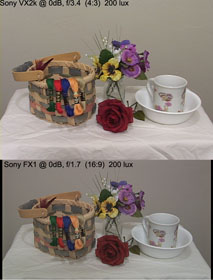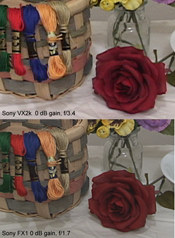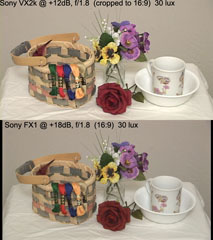Sony FX1 vs VX2k in low light
by John Beale, Aug. 17 2005
Here is a comparison of two Sony cameras, the new HDV-format HDR-FX1
and the older MiniDV DCR-VX2000. I chose three illumination
levels of 200 lux, 30 lux and 11 lux to compare the camera's
images. For reference:
- sunny Summer day: 80,000 lux
- cloudy Winter day: 3000 lux
- office, supermarket: 500 lux
- home interior: 100 lux
- 1 foot from a single candle: 11 lux
The methodology was chosen based on the way I use these
cameras in my event videography. You will have to evaluate its relevance, if any, to
your own usage. SD is most relevant to me because I have not yet had any
customer interest in HD material. Low-light operation is important since that describes
most wedding receptions, and many ceremonies as well.
Sensitivity Comparison
In situations where gain-up is not used (+0 dB) and the cameras are set
to 1/60 sec exposure, the FX1 requires an aperture 2.0 stops wider open
than the VX2000 to achieve the same apparent image brightness
(luminance). For example, aimed at the same target from the same
spot, the VX2k at f/5.6 gives 42 IRE and the FX1 at f/2.8 gives 43
IRE. One stop is equivalent to 20 IRE units near the middle of
the range, although this is not true near the black level. The
two-stop difference is not maintained when gain-up is used.
Sensitivity test target: matte white vellum on wall, flat-lit with
diffused halogen lamp. Sekonic L508 spotmeter reading: EV 7.8.
Both cameras manually white balanced to
this target. Video level measured at center image in IRE units,
using DV firewire input to a laptop running DV-Rack Spectra 60 video
analyser.
Image tests
The FX1 footage recorded in HDV 1080i (cinegamma off), imported
into Vegas 6b, converted to 720x480 (widescreen) and saved in a HuffYUV
(4:2:2) AVI file format. This was in turn exported as a 720x480 PNG,
and scaled to 853x480 in Photoshop to display as 16x9 using 1:1
pixels. To match this image size, the original 720x480 DV video
from the VX2k was scaled up to 853x640 which displays as 4:3 using 1:1
pixels. For the darker two light tests, I then cropped this frame
to 853x480 to match the 16x9 image from the FX1. Video captures from the FX1
show black bands on the extreme left and right hand sides of the frame
(not normally visible, as they are in the TV overscan region).
Video from the VX2k does not have these dark bands.
Incident exposure was measured with a Sekonic L-508 meter. Lights
were diffused 100W standard household bulbs (not halogen).
When gain is employed, each 6 dB should equal 1 f-stop. However
apparently the FX1 and VX2k employ gain in different ways because the 2
f-stop difference diminishes to approx. 1 stop in dark conditions (note
exposure settings in images below).
Using a sharpness setting of 12 on the FX1, exported still frames
appear softer than the
VX2k. This is not due to a lack of real detail, but differences in the
strength of the sharpening between the two cameras. For the detail
image below right, I added
sharpening in Photoshop to the FX1 image to approximately match the
sharpness of the VX2k image. Even after this additional sharpening, the
noise level of the FX1 appears lower. The 4:1:1 color sampling
of the VX2k DV format is most evident in the blocky texture of
the rose and the boundary between the red and blue yarn samples.
It may be expected that the FX1 lens is sharper at f/4 and above than
it is at f/1.7 (wide open, at this particular zoom setting).
For all still frames on this page, the camera shutter speed is 1/60
second. The camcorder shutter speed is selectable between 1/4 and
1/10000 sec, but 1/60 sec is considered the "normal" and most
frequently used setting for NTSC video.
Click on any image
to view a larger version.

FX1 vs VX2k with no gain
|

200% detail crop from image at left
|

30 lux example
|

11 lux example
|
Other notes. 200 Lux image: the FX1 was zoomed in a little bit so f/1.7 was its maximum
aperture at that point. The lens is rated f/1.6 but that applies only to the widest 5% or so of
the zoom range. It's hard to match a VX2k shot at f/1.6 unless you
use an external wide converter on the VX, because the FX1 has a wider
maximum field of view.
I didn't show pictures of the blank-white-paper sensitivity test, but
at least for a flat-white (or gray) field of view at the IRE 43 level
the sensitivity difference is 2 stops, (f/5.6 vs f/2.8) based on my
IRE measurements via DV-Rack, but I don't know how accurate and
uniform the reported f-stops are.
My measurements on the 200-lux image have the
VX2k image 6% or about 1/4 stop brighter than the FX1, based on the
background wall. However the VX2k images look somewhat more
"contrasty" than the FX1 images, suggesting either a different gamma
curve shape or simply wider dynamic range on the FX1. If so then the
observed sensitivity difference will be a function of the IRE level
you compare: highlights, mid-grays, darks.





